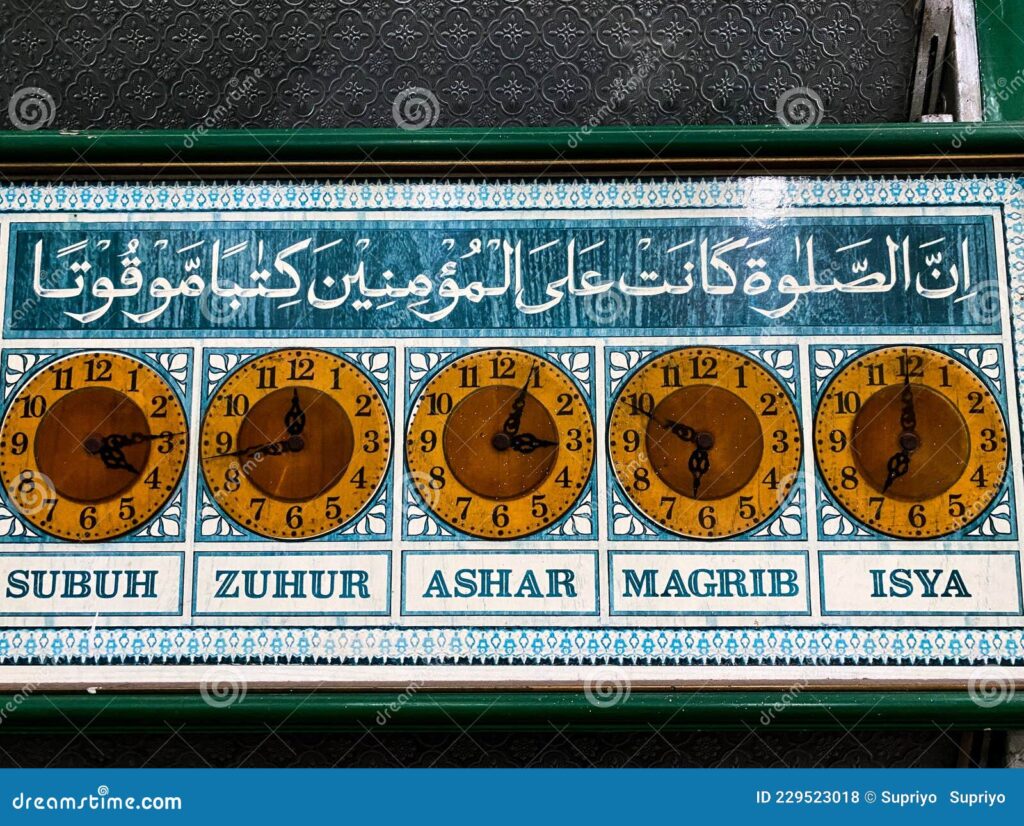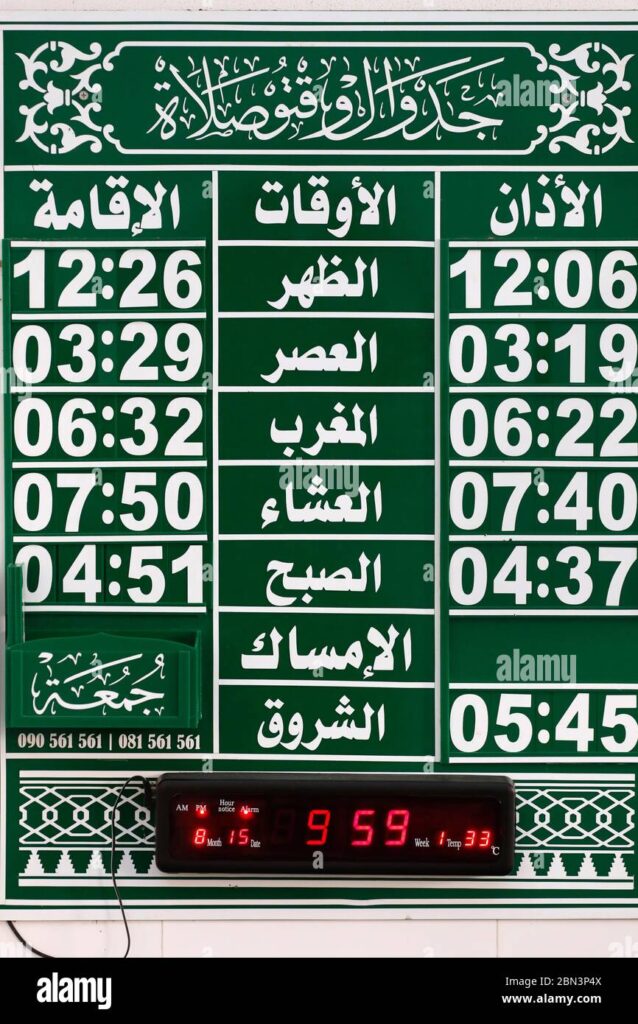When Are Muslim Prayer Times
- When Are Muslim Prayer Times
- Understanding Islamic Prayer Times
- The Five Daily Prayers
- Calculating Prayer Times
- Variations by Location and Season
- Tips for Keeping Track of Prayer Times
When Are Muslim Prayer Times

Muslim prayer times are fundamental to the practice of Islam, marking specific moments of devotion throughout the day. These times are structured around the position of the sun, with five daily prayers, known as Salah, that hold deep spiritual significance. To maintain a meaningful connection with these practices, Muslims adhere to established prayer times determined by both celestial events and local geographical considerations.
Fajr marks the first prayer of the day, performed before dawn. As day breaks, this prayer invites serene reflection to prepare one’s heart and mind for the day ahead. The time for Fajr begins at a specific degree of the sun below the horizon and continues until just before sunrise.
Following Fajr, the second prayer, Dhuhr, occurs after the sun has crossed its zenith. This prayer serves as a moment to pause amidst daily activities, providing a needed spiritual reset. Dhuhr generally begins right after midday and extends until the shadow of an object is equal to its length.
- Holy Quran Part 30 (JUZ AMMA) Book with English Translation (12 Pcs Lot)
- Dr.Mustafa Khattab (Author)
- English (Publication Language)
- 416 Pages - 12/26/2015 (Publication Date) - Message for Humanity (Publisher)
- Karroum, Bachar (Author)
- English (Publication Language)
- 129 Pages - 02/08/2023 (Publication Date) - GoodHearted Books Inc. (Publisher)
The Asr prayer takes place in the late afternoon. The timing for Asr is notably dependent on the variance of Islamic school of thought but is typically observed when the shadow of an object is either equal to its length or longer, depending on one’s interpretation. This prayer provides an essential opportunity to reflect further during the busyness of the day.
As the day wanes, the Maghrib prayer is called immediately following sunset. This prayer not only marks the transition from day to night but also acts as a reminder of the blessings received throughout the day. Maghrib begins instantly after sunset and lasts until the red twilight fades away.
Finally, the Isha prayer occurs at night, providing closure to the day’s spiritual activities. This prayer starts after twilight completely disappears and continues into the middle of the night, giving worshippers a final opportunity for introspection and connection with Allah before the day concludes.
Given this structured approach, calculating the exact times for prayer can become complex, necessitating the use of local prayer time schedules or reliable apps designed to provide precise timings based on one’s geographical location. It is crucial to understand that these timings are not uniform; they vary widely based on seasons and the observer’s location across the globe.
Potential changes in prayer times can occur dramatically during various times of the year. For instance, in summer months, the interval between Fajr and Isha can extend significantly, while in winter these times can be dramatically closer together, impacting how Muslims plan their day-to-day activities.
Ultimately, regardless of the geographic dispositions, the scheduled moments for prayer act as both a rhythmic reminder of the dutiful commitment to faith and an essential tool for time management in the busy lives of Muslims. Understanding when these prayer times occur is vital for both spiritual and practical reasons, and fostering awareness of these timings allows for a deeper experience of daily faith life.
- Holy Quran Part 30 (JUZ AMMA) Book with English Translation (12 Pcs Lot)
- Dr.Mustafa Khattab (Author)
- English (Publication Language)
- 416 Pages - 12/26/2015 (Publication Date) - Message for Humanity (Publisher)
- Karroum, Bachar (Author)
- English (Publication Language)
- 129 Pages - 02/08/2023 (Publication Date) - GoodHearted Books Inc. (Publisher)
Understanding Islamic Prayer Times

Prayer times hold considerable importance in Islam, guiding daily life and spiritual practices for millions around the world. To truly grasp the meaning behind these designated moments, it’s essential to delve into the nuances of Islamic prayer times. When are Muslim prayer times? They are determined based on specific astronomical events, primarily the movement of the sun, which places great emphasis on the connection between faith and nature.
Methods of Timing
Islamic scholars have developed several methods for determining the times for the five daily prayers. Each prayer is anchored in natural phenomena that signify different segments of the day. The timing of these prayers has been standardized over centuries, relying on a combination of tradition and mathematical calculations influenced by the position of the sun.
Fajr is determined by the first light appearing on the horizon, which is defined by the angle at which the sun is below the horizon during dawn. Usually, this is recognized when the sun is approximately 18 degrees below the horizon. Following Fajr, Dhuhr begins after the sun has passed its zenith and starts descending. This transition signifies that it is time for mid-day prayer, allowing worshippers to pause from daily activities to connect spiritually.
Asr involves a slightly more complex calculation, as it can vary based on different schools of thought within Islam. The time for Asr begins when the shadow of an object is either equal to its length or doubled, depending on the interpretation one follows. This variance encourages followers to engage with local communities and scholars to navigate the differences, thereby reinforcing collective practice.
Maghrib prayer is initiated at sunset, similarly signifying a clear and observable natural event. The moment the sun dips below the horizon is promptly followed by the call to prayer, allowing reflection on the day’s events. Isha, the final prayer, is linked to the disappearance of twilight, and it signifies both closure and the opportunity for peaceful contemplation before resting for the night.
Each of these prayer times is closely tied to the rhythm of life. Observing these practices not only fulfills a religious duty but also cultivates mindfulness, encouraging practitioners to take moments of pause throughout their busy day. It creates a sense of discipline and sets a cadence for daily life, inviting Muslims to recalibrate and reconnect with their faith regularly.
Significance of Prayer Times
Understanding Islamic prayer times encompasses more than merely recognizing their schedules. These prayer moments serve as daily reminders of faith, providing structure and a framework for spiritual development. Each prayer symbolizes an opportunity for spiritual rejuvenation and plays an integral role in the holistic practice of being a Muslim.
Moreover, adherence to prayer times fosters a sense of community and shared identity among Muslims. Schools, workplaces, and homes often incorporate prayer breaks, allowing individuals to observe their spiritual obligations while remaining active participants in society. Such integration demonstrates the acceptance of faith as an essential aspect of daily life that deserve respect and understanding from various cultural narratives.
When studying the prayer schedule, it’s also vital to note the challenges that arise in modern contexts, particularly in regions where daylight hours fluctuate significantly throughout the year. During summer months, for instance, the distance between the Fajr and Isha prayers can extend greatly, sometimes making it difficult for individuals to maintain their routine.
- Holy Quran Part 30 (JUZ AMMA) Book with English Translation (12 Pcs Lot)
- Dr.Mustafa Khattab (Author)
- English (Publication Language)
- 416 Pages - 12/26/2015 (Publication Date) - Message for Humanity (Publisher)
- Karroum, Bachar (Author)
- English (Publication Language)
- 129 Pages - 02/08/2023 (Publication Date) - GoodHearted Books Inc. (Publisher)
Prayers can also serve as guiding points within a Muslim’s busy day, reminding them of the divine presence and their commitment to practices instilled by their faith. Understanding when Muslim prayer times are aids in navigating day-to-day activities with intention, purpose, and mindfulness. Knowing the timing not only encourages punctuality in worship but also emphasizes the beauty of faith intertwined with the natural world.
The Five Daily Prayers
The five daily prayers hold significant spiritual and practical value within Islamic practice, serving as essential pillars of a Muslim’s daily routine. Each of these prayers is designed to create a rhythmic pattern throughout the day that encourages mindfulness and reflection. When Are Muslim Prayer Times? These designated moments are intrinsically linked to the phases of the day and the position of the sun, which makes understanding the specific timings crucial for adherence to Islamic practices.
Overview of the Five Prayers
The five prayers are known as Fajr, Dhuhr, Asr, Maghrib, and Isha, and each embraces distinct characteristics and spiritual meanings. The table below presents an overview of these prayer times along with their significance and approximate durations:
| Prayer | Time Frame | Meaning | Typical Duration |
|---|---|---|---|
| Fajr | Before dawn, until just before sunrise | Represents the beginning of the day and spiritual reflection | Approximately 20-30 minutes |
| Dhuhr | From after midday until the shadow of an object is equal to its length | A moment of pause and gratitude during daily activities | Approximately 20 minutes |
| Asr | Late afternoon, varies by interpretation | Encourages further reflection as the day progresses | Approximately 20 minutes |
| Maghrib | Immediately after sunset until twilight fades | Marks the transition from day to night | Approximately 15-20 minutes |
| Isha | At night, after twilight until halfway through the night | Offers closure and tranquility, preparing for rest | Approximately 20-30 minutes |
Each prayer time symbolizes not only an obligation but also an opportunity to connect deeply with one’s faith. The act of praying five times a day helps reinforce the feeling of accountability to Allah, incorporating pauses for reflection amidst the hectic pace of daily life.
Comparison of Prayer Structures
Different regions and cultural practices can lead to variations in how the five prayers are observed. While the fundamental timings remain rooted in Islamic teachings, community traditions and local customs can influence the experience of attending prayer. Importantly, these practices emphasize the essential nature of community engagement within Islam.
In Muslim-majority countries, public prayer gatherings highlight the social dimension of worship. For example, particular emphasis is placed on praying together in mosques, especially for the Jumu’ah prayer on Fridays. In contrast, in countries where Muslims are a minority, individual prayer may be more prevalent, and community prayer practices can take on unique forms.
Additionally, seasonal variations greatly affect how these prayer times are observed. In winter, for instance, days are shorter, making the intervals between prayers closer together, while summer days can extend these intervals significantly. Observers must continually adapt to these changes to maintain a meaningful connection with their prayers.
The Importance of Staying Connected
Maintaining awareness of the prayer timings is vital for Muslims seeking to fulfill their religious obligations. Knowing When Are Muslim Prayer Times allows for better planning in both personal and professional contexts, cultivating a disciplined lifestyle that honors faith commitments.
To assist in keeping track, various tools and methods are available. Many worshippers find utilizing prayer time apps, websites, and local community calendars helpful. These resources provide accurate timings tailored to each local context and can significantly aid in managing daily schedules to include prayer.
Participating in community discussions, attending local mosques, and using public Islamic announcements can also support this connection. Engaging with others helps reinforce the shared responsibility of observing prayer times and fosters a supportive network rooted in mutual faith.
Overall, the five daily prayers are key components of Islamic life that offer spiritual renewal, community connection, and a structure for daily routines. Understanding the significance of these moments underscores the importance of prayer in navigating the complexities of everyday existence. When Are Muslim Prayer Times? They are not just hours in a day, but milestones marking a journey of faith and reflection.
Calculating Prayer Times

Calculating the times for Muslim prayers requires a combination of astronomical knowledge, local observations, and specific methods that have been refined over centuries. When Are Muslim Prayer Times, the determination is primarily based on the solar cycle, particularly the sun’s position in the sky, which can vary significantly depending on geographic location and the time of year.
Astronomical Calculations
The core of calculating Muslim prayer times lies in understanding the sun’s movements. The calculation starts with Fajr, which is established by determining when the sun is approximately 18 degrees below the horizon. Following this, Dhuhr begins not long after when the sun reaches its zenith or highest point in the sky. This intersection of celestial positioning and timekeeping is what makes Islamic prayer times unique.
Asr requires users to consider the length of shadows. Depending on one’s school of thought, Asr can start either when the shadow of an object is its length or double its length. This variation can lead to small differences in times that disciples observe, showcasing how Islamic tradition also embraces local interpretations and practices.
Maghrib prayer is called at sunset, which represents a definitive point in time observable by all. The sun dipping below the horizon is universally recognized, providing a clear marker for this prayer. For Isha, it begins when the twilight disappears and can be determined geometrically or by using civil twilight definitions in commonly available astronomical tools.
Utilizing software and apps that automate these calculations has become increasingly popular among Muslims to ensure timely observance of prayer. Such platforms usually require the user to input their geographic location to offer precise timing, thus connecting personal observance to the collective experience of the faith.
Location-Based Variations
The geographical position plays a crucial role in calculating prayer times. Regions that are closer to the poles experience more extreme variations due to the prolonged daylight during summers and the extended darkness during winters. In such locations, scholars often adopt unique adjustment methods to ensure that Muslims can pray on time without undue hardship.
In equatorial regions, where day and night are relatively equal throughout the year, calculations tend to be more straightforward. Here, the solar cycle remains consistent, allowing for well-established prayer times that do not significantly change seasonally. Regardless of location, advances in technology have provided tools that can generate accurate prayer times irrespective of historical challenges.
For travelers or those living in areas with limited sunset visibility, particularly during the summer months, it is essential to consult local mosques or community organizations, as they often provide updated prayer time schedules that account for local conditions and regional variations.
Technological Assistance
In the modern world, technological advancements have made tracking prayer times more accessible and efficient. There are numerous applications available that not only indicate the times based on location but also send alerts and notifications to remind users of prayer times throughout the day. These tools are particularly helpful for students and professionals with busy schedules, ensuring they maintain their spiritual obligations amid their daily activities.
Additionally, many Islamic centers and mosques offer printed schedules that detail daily prayer times, allowing community members to sync their routines accordingly. Websites dedicated to Islamic content also provide prayer time calculators, often based on latitude and longitude of the user’s area. Furthermore, resources like IslamicFinder present a reliable source for Muslims to find prayer times and locate local mosques.
By utilizing these modern tools, adherents of Islam can better connect with their spiritual practices, regardless of changing conditions or varying locations. Keeping track of prayer times becomes less of a challenge when integrated into daily life through technological assistance.
The Role of Local Communities
The importance of community in helping Muslims calculate and adhere to prayer times cannot be overstated. Islamic centers often provide educational workshops that explain the methodologies behind determining prayer times, instilling a deeper understanding of why precision is important. This knowledge fosters a sense of connection among community members, as they work together to keep track of prayer times collectively.
Social media and online platforms have also become pivotal in disseminating information regarding prayer timings and organizing communal prayers. Many local groups and religious organizations utilize these platforms to announce prayer times, especially during Ramadan and significant Islamic events. Such collaborations not only help individuals stay informed about When Are Muslim Prayer Times but also strengthen communal bonds, encouraging collective worship.
In conclusion, understanding how to calculate prayer times is vital for Muslims seeking to fulfill their daily spiritual duties. By combining astronomical knowledge, local geographical information, and modern technology, obtaining accurate prayer schedules has never been easier, enabling Muslims to maintain their connection with Allah throughout their day.
Variations by Location and Season

The timing of Muslim prayers is not a static framework but rather a dynamic aspect influenced by geographical variations and seasonal changes. When Are Muslim Prayer Times, Muslims must adapt their practices to the environmental context in which they live. In different parts of the world, the sun’s trajectory can result in significant disparities in the timing and duration of prayer opportunities throughout the year.
During the summer months, especially in regions at higher latitudes, the intervals between the Fajr and Isha prayers can extend considerably. Sunlight lingers for much longer, meaning that the time for Fajr occurs very early in the morning, while Isha is pushed later into the night. In some extreme cases, there may be instances where Fajr and Isha come alarmingly close together, creating complications for those trying to observe both prayers appropriately. Some communities may adopt local Islamic authorities’ guidelines for these situations, allowing for a more practical approach that ensures spiritual needs are met without undue hardship.
Conversely, winter brings its own unique challenges. The sun rises later and sets earlier, which compresses the times available for prayer. For instance, Fajr might happen around six or seven in the morning, while Isha can occur just after sunset, leading to shorter breaks between prayers during the day. This seasonal compression can have a profound impact on how Muslims plan their daily routines and may require adjustments in work schedules or family activities to accommodate the spiritual practice.
In equatorial regions, where day and night lengths remain relatively constant throughout the year, prayer times are easier to calculate and adhere to. Muslims in these areas often experience less fluctuation in their prayer timings, allowing them the stability needed for consistent practice. The sun rises and sets in a predictable manner, making the timing of the five daily prayers easier to anticipate.
Furthermore, mountainous and coastal environments can also introduce additional complexities. Topographical features may lead to variations in sunset times—where individuals living at higher elevations may see sunset earlier than those residing in valleys. In such cases, local knowledge of the environment becomes essential, as prayer times can fluctuate based on how the landscape affects the view of the horizon.
In urban settings, tall buildings and city structures can similarly cast shadows that influence the local timing of prayers, particularly during times such as Asr, where the shadow’s length dictates the start time. Residents in metropolitan areas are often encouraged to seek guidance from their local mosques, which provide tailored prayer timings that accommodate these urban realities.
To assist Muslims in staying connected with their prayer schedules, many communities have also embraced technology. Numerous apps and online platforms provide personalized prayer time notifications based on one’s specific geographical location. These tools are especially vital during times when seasonal variations affect traditional daylight hours—whether it is the ethereal light of summer evenings or the long, celestial stretches of winter days.
By embracing both local practices and modern technology, Muslims can navigate the many challenges associated with varying prayer times, making their spiritual lives more harmonious with their daily activities. Understanding how environmental and seasonal factors influence prayer timings reinforces the precious bond between religious practices and the natural world, allowing all to engage fully with their faith. When Are Muslim Prayer Times? They represent a harmony of celestial mechanics intertwined with individual dedication, where awareness and adaptability play key roles in the observance of Salah.
Tips for Keeping Track of Prayer Times
Keeping track of Muslim prayer times is an essential aspect of practicing Islam effectively and with devotion. With the multiplicity of daily responsibilities, the challenge of remembering the exact times for Fajr, Dhuhr, Asr, Maghrib, and Isha may seem daunting. However, Muslims can utilize several practical strategies and innovative tools to ensure that they perform their prayers on time and maintain their spiritual commitment.
Leveraging Technology for Prayer Tracking
In our fast-paced world, technology can be a powerful ally in managing the scheduling of daily prayers. Many mobile applications are designed specifically to inform users of prayer times based on their geographical location. By inputting their coordinates or allowing location access, users can receive instant notifications for upcoming prayers. Applications such as Muslim Pro, IslamicFinder, and Ummah offer reliable features, including accurate prayer time calculations, notifications, and even the direction of Qibla.
Moreover, these applications often include additional functionalities, such as reminders for Ramadan fasting, nightly Taraweeh prayers during the holy month, and even Qur’an readings. By embracing these mobile solutions, practitioners of Islam can seamlessly integrate their prayer schedules into their daily routines, ensuring that they remain connected with their spiritual lives throughout the day.
Community Resources and Local Mosques
Another effective way to keep track of prayer times is through the resources provided by local mosques. Islamic centers often publish prayer schedules on their websites or distribute printed materials that specify prayer times for the entire month. Some mosques may even adjust prayer times seasonally, recognizing the variations in daylight hours. Engaging with local communities also fosters a stronger sense of belonging and offers an avenue for individuals to participate in group prayers, thus enhancing spiritual unity.
Moreover, many mosques organize prayer calendars showing the prayers for each day along with the times for upcoming Jumu’ah (Friday congregational) prayers. By actively participating in the community, individuals remain attuned to changes in prayer timings and can rely on the collective knowledge and experience of those around them.
Utilizing Wall Clocks and Timers
In addition to digital solutions, traditional methods such as using designated wall clocks or timers can effectively remind practitioners of prayer times. Many stores offer Islamic wall clocks that display prayer times and even announce the call to prayer vocally. These clocks can be particularly beneficial in homes, workplaces, or areas where distractions may cause individuals to lose track of time. Setting alarms on personal devices for each prayer can also serve, ensuring reminders occur at intervals that work best for individual schedules.
Cultural Adaptability
Recognizing that prayer times may vary depending on the individual’s environment is crucial. For Muslims living in regions with extreme seasonal variations, such as the Northern Hemisphere, it may help to adapt prayer practices to local daylight realities. In such cases, consulting local Islamic authorities and adhering to their guidance can clarify how to adjust prayer patterns accordingly.
For instance, some scholars in areas with prolonged daylight suggest combining prayers during summer months (such as Dhuhr with Asr and Maghrib with Isha) to ease the burden of long waits between prayers. This flexibility allows individuals to continue fulfilling their religious obligations while accommodating the practicalities of daily life.
Staying Mindful and Intentional
Ultimately, the key to successfully keeping track of prayer times lies in developing a mindset of mindfulness and intentionality. By cultivating a habit of regularly checking prayer schedules and planning daily activities around these times, individuals can integrate prayer seamlessly into their routines. This approach can encourage a deeper connection with spirituality and a greater awareness of the significance of each prayer within the broader framework of daily life.
Silencing notifications on mobile devices or designating specific prayer spaces free from distractions can enhance the prayer experience. Selecting serene environments for private or family prayers can foster a deeper sense of reflection and spiritual connection.
Sharing Responsibility
If living with family or members of the community, sharing the responsibility of keeping track of prayer times can be beneficial. Creating a group chat or communal schedule can encourage everyone to stay aware of when prayers are due and coordinate together, thus fostering a sense of community. Feeling accountable to one another can boost individual motivation and ensure that everyone maintains their spiritual obligations throughout the day.
Enhancing communication within family and community circles regarding prayer times not only cultivates a culture of mutual support but also encourages joint participation in worship. Community events, including discussions about prayer timings and spiritual practices, can provide valuable context, enabling everyone to share their experiences and techniques for maintaining a robust prayer life.
By embracing these strategies, Muslims can overcome the challenges associated with tracking prayer times. Whether through modern technological tools or traditional community engagement, varying methods allow individuals to remain committed to their spiritual practices. Ultimately, understanding the significance of observing timely prayers underscores the essence of When Are Muslim Prayer Times, ensuring that daily worship becomes an integral part of life rather than an obligation stressed by daily tasks.



















Post Comment